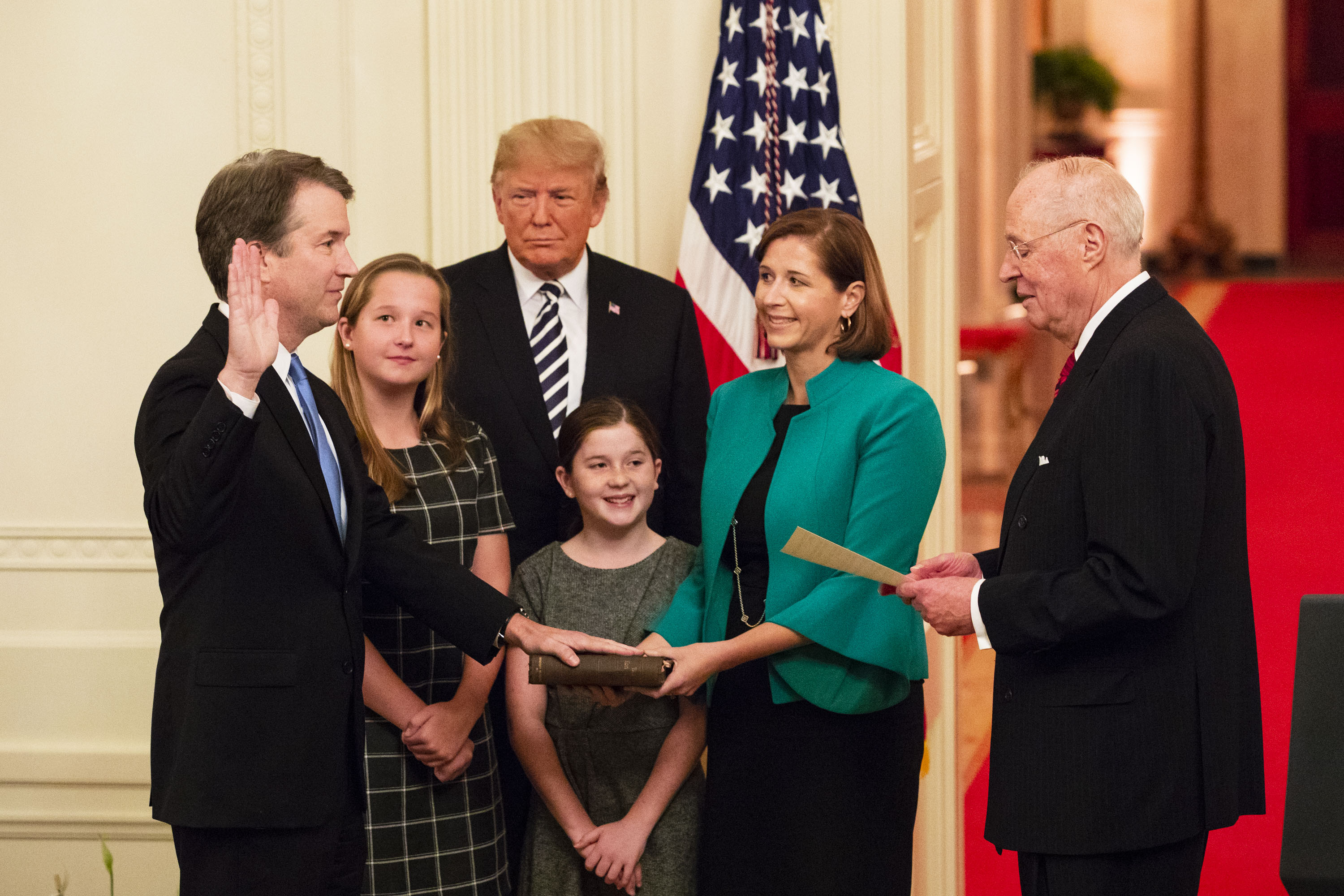In response to Trump’s ever-growing number of judicial appointments since taking office, a growing number of left-leaning pundits and Democratic candidates have become proponents of court-packing. Have they forgotten the lessons of history?
Transitions from one U.S. President to the next have long been characterized by a newly-elected President enthusiastically abrogating the policies and initiatives his predecessor worked so hard to implement. In an attempt to avoid such a fate, John Adams rushed desperately in his final days in office to secure his Presidential legacy against the whims of his successor, dear friend, and political nemesis Thomas Jefferson. In passing the landmark Judiciary Act of 1801, Adams established the first circuit judgeships and reorganized the federal judiciary, granting himself the sweeping ability to appoint a host of Federalist judges before leaving office.
“The act and the ensuing last-minute appointment of new judges (the so-called ‘midnight judges’) were decried by the incoming president, Thomas Jefferson, and his Republican allies as an attempt by the outgoing president and his Federalist allies to retain their party’s control of the judiciary by packing it with their supporters,” explains Professor Melvin Urofsky of Virginia Commonwealth University. The act would be repealed just one year later, but the appointment of the midnight judges set a dangerous precedent that lives on to this day, perhaps stronger than ever.
President Donald Trump’s behavior (in this respect, at least) has not varied from the norm, having tried obsessively since assuming office to reverse a multitude of Obama-era initiatives, from Obamacare and DACA, to sweeping environmental protections and the Iran nuclear deal. In due time, many of Trump’s policies will likely be reversed as well. But there is one facet of Trump’s Presidencythat will be etched in stone long after his Twitter page goes silent (or is taken down): his impact on the federal judiciary, a reality experts on both sides of the aisle recognize with varying degrees of delight and concern.
Say what you will about Trump’s failure to follow through on a litany of key campaign proposals, let alone the underlying currents of chaos, confusion, and general commotion that have come to define his Presidency. When it comes to appointing and confirming white, male, conservative judges, Trump is a force to be reckoned with. Trump’s record-setting performance is a sight to behold, and the ramifications are already being seen in landmark court decisions across the country.
Just over two years into his first term, Trump has already appointed a staggering one-quarter of all sitting federal circuit judges, and one-seventh of all district court judges. But why has Trump had the opportunity to fill such a high number of vacancies? Rutgers Law Professor Stacey Hakins explains: “Due to delays in senate confirmation of many of President Obama’s judicial nominees under majority leader Mitch McConnell (R-KY), President Trump inherited an unusually large number of vacancies on the federal court. In total, Trump has already had the opportunity to fill approximately 216 of the 890 seats on the federal court, or almost 25 percent of the entire federal bench in just his first two years in office.”
Though Trump’s appointments of Justices Kavanaugh and Gorsuch were public affairs soliciting much coverage, his other appointments have come and gone without much hand–wringing. A recent UCLA Law Review articles sums it all up well. “As much attention has been focused on scrutinizing President Trump’s two appointments to the United States Supreme Court, a more pervasive and insidious effort by President Trump to remake the federal judiciary has gone relatively unchallenged. Our collective obsession with the nation’s highest court and its shifting ideological balance since the retirement of longtime moderate Justice Anthony Kennedy, while important, has allowed a less notable but no less important shift to occur in the judiciary as a result of Trump’s record-setting pace of appointments to the lower federal courts.”
Trump has been astoundingly forthcoming and sensible in the wake of it all, accepting that his judicial appointments may be the most lasting impact of his beleaguered Presidency. And experts agree: “Perhaps the most successful area for the Trump administration has been the nomination of judges,” says Professor Josh Blackman, a conservative legal scholar at the South Texas College of Law. It is a reality Trump seems perfectly fine with, given an increasingly partisan, politicized, and consequential Supreme Court. Trump realizes that this is where he can make an impact that far outlives his time in office.
Democrats aren’t about to take this lying down – far from it. But in a gale of pent-up animosity they have made a terrible mistake in suggesting the possibility of court-packing, the notion of increasing the size of the Supreme Court. Having largely been banished to the sidelines of conventional policy after being attempted by President Roosevelt in 1937, the possibility of court-packing has found its way back into mainstream discussion. In addition to a growing litany of op-eds expressing support for the notion, five leading Democratic Presidential candidates have expressed some degree of sympathy for the idea.
Democrats may have a reason to be concerned about the current composition of the Supreme Court, but court-packing is an incredibly dangerous game. In a recent article, Steven Livtsky and Daniel Ziblatt, authors of How Democracies Die, don’t pull any punches: “Without robust norms, constitutional checks and balances do not serve as the bulwarks of democracy we imagine them to be. Institutions become political weapons, wielded forcefully by those who control them against those who do not. This is how elected autocrats subvert democracy – packing and ‘weaponizing’ the courts and other neutral agencies.”
In a 2017 paper entitled How to Lose a Constitutional Democracy University of Chicago law professors Tom Ginsburg and Aziz Huqconcur: “The presidential effort to pack the Supreme Court represents a low point for the rule of law in the United States, and is a technique that has been followed by modern-day illiberal democrats.” But Democrats must not only heed the words of Ziblatt and Livtsky, and the chorus of other experts that have tried to pump the brakes in recent weeks – they must simply look to history.
Take Argentina, for example. In 1946, Juan Perón, a former coup conspirator and populist impeached four out of five justices in an attempt to consolidate his power. In doing so, he set an unfortunate precedent: 43 years later, Argentinian President Carlos Menem expanded the Supreme Court from five to nine justices, limiting judicial opposition as he tried to push through the privatization of various industries. Similar situations can be seen in Turkey under Recep Tayyip Erdogan,Hungary under Viktor Orban, and Poland under Andrez Duda. In each case, packing the courts has been a dangerous first step towards the authoritarian states we see today. Does the U.S. want to join this infamous list of increasingly authoritarian states? Presumably not.
But what is more worrying than the destructive impact court-packing can have on the viability of democracy and its supporting institutions within the U.S., is the slippery slope it will inevitably set the U.S. down, causing further unintended consequences for the long-term health of American democracy. If the next Democratic President did increase the Supreme Court to 15 justices, appointing six during his or her term, how would Mitch McConnell and the Republican party respond? Would a later Republican president simply increase the limit further to compensate?
Roosevelt’s proposed Judicial Reforms Bill of 1937 was never enacted into law, largely due to overwhelming public outcry. Though a series of polls conducted from February to May of 1937 confirmed that the public opposed FDR’s proposed legislation by a fluctuating majority, by late March the verdict was in without a fraction of a doubt. Bar associations across the country lined up in vehement opposition to the bill. A widespread letter-writing campaign to Congress commenced, with opinion tallying against the bill coming in at nine-to-one. Even Roosevelt’s own Vice-President, John Nance Garner, expressed his doubts. Nearly a century later, it’s time that legal authorities and concerned citizens similarly unite to put a stop to the idea of court-packing.
Featured Image: President Donald J. Trump looks on as Anthony M. Kennedy, retired Associate Justice of the Supreme Court of the United States, swears in Judge Brett M. Kavanaugh to be the Supreme Court’s 114th justice. (2018), by The White House via flickr. Public domain.
Disclaimer: Any views or opinions expressed in articles are solely those of the authors and do not necessarily represent the views of the NATO Association of Canada.




